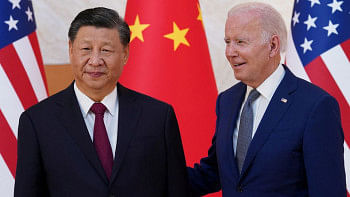America’s wars and the US debt crisis

In the year 2000, the US government debt was $3.5 trillion, equal to 35 percent of GDP. By 2022, the debt was $24 trillion, equal to 95 percent of GDP. The US debt is soaring, hence America's current debt crisis. Yet, both Republicans and Democrats are missing the solution: stopping America's wars of choice and slashing military outlays.
Suppose the government's debt had remained at a modest 35 percent of GDP, as in 2000. Today's debt would be $9 trillion, as opposed to $24 trillion. Why did the US government incur the excess $15 trillion in debt?
The single biggest answer is the US government's addiction to war and military spending. According to the Watson Institute at Brown University, the cost of US wars from fiscal year 2001 to fiscal year 2022 amounted to a whopping $8 trillion, more than half of the extra $15 trillion in debt. The other $7 trillion arose roughly equally from budget deficits caused by the 2008 financial crisis and the Covid-19 pandemic.
To surmount the debt crisis, the US needs to stop feeding the Military-Industrial Complex (MIC), the most powerful lobby in Washington. As President Dwight D Eisenhower famously warned on January 17, 1961, "In the councils of government, we must guard against the acquisition of unwarranted influence, whether sought or unsought, by the military-industrial complex. The potential for the disastrous rise of misplaced power exists and will persist." Since 2000, the MIC has led the US into disastrous wars of choice in Afghanistan, Iraq, Syria, Libya, and now Ukraine.
The MIC long ago adopted a winning political strategy by ensuring that the military budget reaches into every Congressional district. The Congressional Research Service recently reminded Congress, "Defense spending touches every Member of Congress's district through pay and benefits for military service members and retirees, economic and environmental impact of installations, and procurement of weapons systems and parts from local industry, among other activities." Only a brave member of Congress would vote against the military-industry lobby, yet bravery is certainly no hallmark of Congress.
The US' annual military spending is now around $900 billion, roughly 40 percent of the world's total, and greater than the next 10 countries combined. US military spending in 2022 was triple that of China. According to the Congressional Budget Office, the military outlays for 2024-2033 will be a staggering $10.3 trillion on current baseline. A quarter or more of that could be avoided by ending its wars of choice, closing down many of the country's 800 or so military bases around the world, and negotiating new arms control agreements with China and Russia.
Yet, instead of peace through diplomacy and fiscal responsibility, the MIC regularly scares the American people with a comic-book style depiction of villains whom the US must stop at all costs. The post-2000 list has included Afghanistan's Taliban, Iraq's Saddam Hussein, Syria's Bashar al-Assad, Libya's Muammar Gaddafi, Russia's Vladimir Putin, and recently, China's Xi Jinping. War, we are repeatedly told, is necessary for America's survival.
A peace-oriented foreign policy would be opposed strenuously by the military-industrial lobby, but not by the public. Significant public pluralities already want less, not more, US involvement in other countries' affairs, and less, not more, US troop deployments overseas. Regarding Ukraine, Americans overwhelmingly want a "minor role" (52 percent) rather than a "major role" (26 percent) in the conflict between Russia and Ukraine. This is why neither Biden nor any recent president has dared to ask Congress for any tax increase to pay for the US' wars. The public's response would be a resounding "No!"
While America's wars of choice have been awful for the country, they have been far greater disasters for countries that it purports to be saving. As Henry Kissinger famously quipped, "To be an enemy of the United States can be dangerous, but to be a friend is fatal." Afghanistan was America's cause during 2001 to 2021, until the US left it broken, bankrupt, and hungry. Ukraine is now in America's embrace, with the same likely results: ongoing war, death, and destruction.
The military budget could be cut prudently and deeply if the US replaced its wars of choice and arms races with real diplomacy and arms agreements. If presidents and Congresses had only heeded the warnings of top American diplomats such as William Burns, the US ambassador to Russia in 2008, and now CIA director, the US would have protected Ukraine's security through diplomacy, agreeing with Russia that the US would not expand Nato into Ukraine if Russia also kept its military out of Ukraine. Yet, relentless Nato expansion is a favourite cause of the MIC; new Nato members are major customers of US armaments.
The US has also unilaterally abandoned key arms control agreements. In 2002, the country unilaterally walked out of the Anti-Ballistic Missile Treaty. And rather than promote nuclear disarmament, as the US and other nuclear powers are required to do under Article VI of the Nuclear Non-Proliferation Treaty, the MIC has sold the Congress on plans to spend more than $600 billion by 2030 to "modernise" the US nuclear arsenal.
Now the MIC is talking up the prospect of war with China over Taiwan. The drumbeats of war with China are stoking the military budget, yet war with China is easily avoidable if the US adheres to the One China policy that properly underpins US-China relations. Such a war should be unthinkable. More than bankrupting the US, it could end the world.
Military spending is not the only budget challenge. Ageing and rising healthcare costs add to the fiscal woes. According to the Congressional Budget Office, debt will reach 185 percent of GDP by 2052 if current policies remain unchanged. Healthcare costs should be capped while taxes on the rich should be raised. Yet, facing down the military-industrial lobby is the vital first step to putting America's fiscal house in order, needed to save the country, and possibly the world, from America's perverse lobby-driven politics.
Jeffrey D Sachs is a world-renowned economist, academic, and public policy analyst who serves as the director of the Center for Sustainable Development at Columbia University.

 For all latest news, follow The Daily Star's Google News channel.
For all latest news, follow The Daily Star's Google News channel. 












Comments